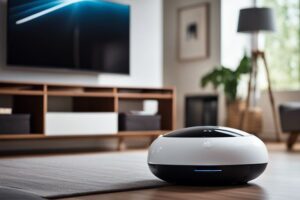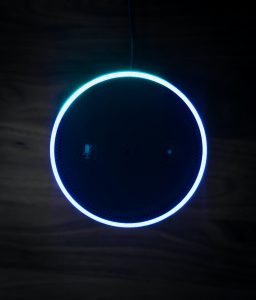Ensuring clean and healthy air in your home is crucial for your well-being, but it can be difficult to know exactly what’s in the air you breathe. With the increasing concern about indoor air pollution, it’s important to invest in smart home gadgets that can monitor and control the indoor air quality for you. In this informative blog post, we will explore the The 6 Best Air Quality Monitors of 2023 and discuss how they can help you achieve cleaner and healthier air in your home. By the end of this post, you will have a better understanding of the best smart home gadgets available to monitor and control indoor air quality, and how they can benefit you and your family.
Key Takeaways:
- Importance of Indoor Air Quality: It is crucial to monitor and control indoor air quality for a healthy living environment.
- Smart Thermostats: These gadgets help in controlling temperature and humidity levels, improving air quality.
- Air Quality Monitors: These devices help in monitoring pollutant levels and provide real-time data to take necessary actions.
- Air Purifiers: Smart air purifiers can automatically detect and filter out harmful particles, improving air quality.
- Ventilation Systems: Smart ventilation systems can help in regulating air circulation and removing stale air, contributing to better indoor air quality.
Chapter: Understanding Air Quality Indicators
Particulate Matter (PM2.5 and PM10)
Particulate matter refers to tiny particles in the air that can be harmful to your health when inhaled. PM2.5 and PM10 specifically refer to particles that are smaller than 2.5 and 10 micrometres in diameter, respectively. These particles can come from sources such as smoke, dust, and vehicle emissions. Exposure to high levels of particulate matter can lead to respiratory issues and cardiovascular problems.
Volatile Organic Compounds (VOCs)
Volatile organic compounds, or VOCs, are chemicals that can evaporate into the air at room temperature. Common sources of VOCs include household products such as paints, cleaning agents, and air fresheners. Prolonged exposure to VOCs can cause headaches, dizziness, and irritation of the eyes, nose, and throat. In some cases, VOCs can also have long-term health effects.
Carbon Dioxide (CO2) Levels
Monitoring carbon dioxide levels in your indoor environment is crucial, as high levels of CO2 can indicate poor ventilation. When you breathe in an enclosed space, you release CO2, and if the area is poorly ventilated, CO2 levels can rise. This can lead to symptoms such as drowsiness, headaches, and an overall feeling of discomfort. In extreme cases, high levels of carbon dioxide can even be life-threatening.
Humidity and Temperature
Proper humidity and temperature levels are vital for maintaining a healthy indoor environment. Imbalanced humidity levels can lead to issues such as mould growth, while extreme temperatures can affect your comfort and well-being. Here are the recommended levels for humidity and temperature in your home:
| Indicator | Recommended Levels |
| Humidity | 30-50% |
| Temperature | 20-22°C |
Keeping an eye on these indicators can help you create a healthier and more comfortable living space for you and your family.
Top Smart Gadgets for Air Quality Monitoring
When it comes to monitoring and controlling indoor air quality in your home, there are several smart gadgets available that can help you achieve this. These gadgets are designed to provide you with real-time information about the air you and your family are breathing, as well as the ability to make adjustments to improve air quality. In this chapter, we will explore the top smart gadgets for air quality monitoring and how they can benefit your home environment.
Standalone Air Quality Monitors
If you are looking for a straightforward and efficient way to monitor the air quality in your home, standalone air quality monitors are a great option. These devices can measure various pollutants such as particulate matter, volatile organic compounds, and carbon dioxide. Some models also have the ability to detect temperature and humidity levels. With a standalone air quality monitor, you can receive accurate and up-to-date information on the air in your home, allowing you to take the necessary steps to improve it.
Integrated Smart Home Systems
Integrated smart home systems offer a comprehensive approach to monitoring and controlling indoor air quality. These systems typically include a range of sensors that can detect pollutants and other elements that affect air quality. They are designed to work seamlessly with other smart devices in your home, allowing you to automate the operation of air purifiers, humidifiers, and ventilation systems based on the real-time air quality data they provide. With an integrated smart home system, you can enjoy the convenience of a fully automated air quality control solution.
Wearable Air Quality Sensors
For those who want to take their air quality monitoring to the next level, wearable air quality sensors are an innovative option. These small, portable devices can be worn on your person and provide you with personalised air quality data. They can monitor your exposure to pollutants, allergens, and other harmful substances, allowing you to make informed decisions about your indoor and outdoor activities. With a wearable air quality sensor, you can gain a deeper insight into the air you breathe.
Smart Gadgets for Improving Indoor Air Quality
When it comes to your indoor air quality, it’s essential to have the right smart gadgets to monitor and control it. With the advancement of technology, there are various smart home gadgets available to help you improve the air quality in your home. Here are some of the best smart gadgets to consider for achieving a healthier indoor environment.
Smart Air Purifiers
If you’re looking to improve the air quality in your home, a smart air purifier is a must-have gadget. These devices use advanced filtration systems to effectively remove airborne pollutants such as dust, pollen, pet dander, and even harmful microorganisms. Additionally, they can be controlled remotely through a smartphone app, allowing you to monitor and adjust the purifier settings from anywhere in your home. With the ability to purify the air in a specific room or the whole house, smart air purifiers can significantly reduce your exposure to allergens and pollutants, leading to cleaner and healthier indoor air.
Intelligent Ventilation Systems
Intelligent ventilation systems are designed to regulate the airflow in your home, ensuring that fresh air is constantly circulated while expelling stale air. These smart gadgets can automatically adjust the ventilation levels based on the indoor air quality, humidity, and temperature. By optimising the airflow, intelligent ventilation systems can prevent the build-up of harmful pollutants, reduce the risk of condensation and mould growth, and maintain a comfortable and healthy indoor environment.
Automated Air Conditioning and Heating Units
Automated air conditioning and heating units are essential smart gadgets for maintaining optimal indoor air quality throughout the year. These systems can be programmed to regulate the temperature and humidity levels, as well as to monitor the air quality in your home. By efficiently controlling the indoor climate, automated air conditioning and heating units can help you to minimise the presence of indoor pollutants, prevent the formation of allergens, and create a comfortable and healthy living environment.
Integrating Devices for Optimal Performance
When it comes to monitoring and controlling indoor air quality, integrating smart home devices can significantly enhance the performance of your air quality management system. By connecting various gadgets, you can create a more comprehensive and efficient solution for ensuring the air you breathe is clean and healthy.
Using Smart Hubs and Assistants
Smart hubs and assistants play a crucial role in integrating different smart home gadgets for monitoring and controlling indoor air quality. You can centralise the management of your air quality devices through a smart hub, allowing you to monitor and control multiple devices from a single interface. This streamlines the process and provides you with a more holistic view of your indoor air quality. Additionally, smart assistants such as Amazon Alexa or Google Assistant enable voice control, making it even more convenient for you to manage your air quality devices.
IFTTT and Automation for Air Quality Management
IFTTT (If This Then That) is a powerful tool for automating the management of your air quality devices. By creating customised applets, you can set up triggers and actions that automatically adjust your devices based on specific conditions. For example, you can set your air purifier to turn on when the air quality sensor detects an increase in pollutants. This level of automation not only simplifies the process for you but also ensures that your air quality devices are actively responding to changing conditions in your home.
Data Analytics and App Integration
Data analytics and app integration are key components of a smart air quality management system. By leveraging data from your air quality devices, you can gain valuable insights into patterns and trends that impact indoor air quality. This information allows you to make informed decisions about how to improve the air in your home. Furthermore, app integration allows you to access and control your air quality devices from your smartphone, giving you the flexibility to manage your system from anywhere. With the ability to track and analyse air quality data, you can take proactive measures to address any issues and ensure a healthy indoor environment for you and your family.
Summing up the Best Smart Home Gadgets for Monitoring and Controlling Indoor Air Quality
In conclusion, when it comes to monitoring and controlling indoor air quality in your smart home, there are a few key gadgets that stand out. Devices such as smart air purifiers, humidity monitors, and air quality sensors can provide you with real-time data and the ability to adjust settings remotely. Additionally, smart thermostats with air quality monitoring features can help you maintain a comfortable and healthy environment. By investing in these smart home gadgets, you can take proactive steps to ensure that the air in your home is clean and safe for you and your family. Prioritising indoor air quality is essential for your overall well-being, and with the right smart home gadgets, you can easily achieve and maintain a healthy living environment.
FAQ
Q: What are the best smart home gadgets for monitoring and controlling indoor air quality?
A: The best smart home gadgets for monitoring and controlling indoor air quality include smart air purifiers, smart thermostats with air quality sensors, smart air quality monitors, and smart ventilation systems. These gadgets can help you to maintain a healthy indoor environment by monitoring and controlling factors such as air pollutants, humidity levels, and ventilation.
Q: What are the benefits of using smart home gadgets for indoor air quality?
A: Using smart home gadgets for indoor air quality offers several benefits, such as improved respiratory health, reduced risk of indoor air pollution-related illnesses, energy savings through efficient ventilation and heating/cooling control, and the convenience of monitoring and controlling air quality from anywhere through mobile apps or voice control.
Q: How do smart air purifiers work?
A: Smart air purifiers use sensors to detect air pollutants such as dust, allergens, and volatile organic compounds (VOCs). They then automatically adjust their filtration settings to effectively remove these pollutants from the air. Some smart air purifiers also provide real-time air quality data and can be controlled remotely through a mobile app or voice commands.
Q: What features should I look for in a smart thermostat with air quality sensors?
A: When choosing a smart thermostat with air quality sensors, look for features such as the ability to monitor indoor air quality levels, integrate with other smart home devices for holistic air quality control, and provide energy usage reports. Additionally, consider compatibility with your HVAC system and the ease of use of the accompanying mobile app or interface.
Q: How can smart air quality monitors help improve indoor air quality?
A: Smart air quality monitors continuously track indoor air quality parameters such as particulate matter levels, humidity, and temperature. By providing real-time data and alerts, they empower you to take proactive measures to improve air quality, such as adjusting ventilation, turning on air purifiers, or identifying sources of indoor air pollution.
Q: Are smart ventilation systems worth investing in for indoor air quality control?
A: Smart ventilation systems are worth investing in for indoor air quality control as they can optimise airflow based on indoor air quality measurements, humidity levels, and occupancy. This not only enhances air quality but also helps to prevent moisture-related issues such as mould and mildew, contributing to a healthier indoor environment.
Q: How can I integrate smart home gadgets for indoor air quality into my existing smart home ecosystem?
A: Many smart home gadgets for indoor air quality are compatible with popular smart home platforms such as Amazon Alexa, Google Assistant, and Apple HomeKit. This allows for seamless integration and unified control of multiple devices through a single interface. Additionally, look for gadgets that support open protocols like Zigbee or Z-Wave for broader compatibility with smart home ecosystems.








